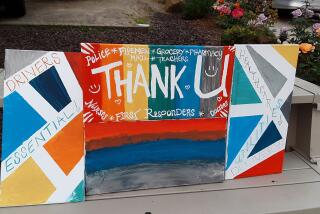Taste of Altruism : Students Find Fun in Doing Volunteer Work
- Share via
United Press International
In a script that zigged and zagged, an elderly resident of Hudson, Ohio, wrote:”I’m very grateful and wish I could do something for you.”
Hudson High youths reading the note had cleaned snow off her walk as part of their community service.
No payment was allowed. Or expected.
Students doing such things get a taste of altruism, authorities claim. And if the experience is positive, they stand a good chance of integrating volunteer work into their adult lives.
Charles H. Harrison, an associate of the Carnegie Foundation for the Advancement of Teaching in Princeton, N.J., related the episode to illustrate a lesson not found in the classroom or in a textbook: Helping others makes you feel good and often in ways that are hard to describe.
Only experiences teaches it.
Harrison tells about the Hudson students and others involved in community service work in a new Foundation report, “Student Service.”
Such work is done in hospitals, nursing homes, day-care centers, churches and schools.
Some Earn Credits
Some of the school-based community programs include work done for high school credit, others, for no credit. Some are voluntary and others are mandatory.
The report also covers student service programs in Atlanta; Detroit; Greenwich, Conn.; Washington, D.C.; Brewster, N.Y., and other places.
“Some service programs are created to give students experience in a career field (health and education, for example),” he said.
“However, most of the programs reported . . . were primarily intended to provide students with an altruistic experience and genuine satisfaction of the kind the two . . . Ohio students felt knowing they had pleased and assisted someone else.”
The report includes information from 1,103 questionnaires sent to 5,500 public schools in 1985.
Seventy percent of respondents said they operated programs for students on either in-school or out-of-school projects. Among those, 80% said the program is voluntary and 20% said it is compulsory.
Other findings:
- Sixty-five percent of the respondents said more than 50% of the students took part in the pro grams.
- Eighty percent of the respondents said students are placed in situations designed primarily for altruistic service; 20% for career orientation.
- Forty-six percent of the schools offer academic credit for student service.
- Service programs have been in effect more than three years in 77% of the schools.
Harrison’s report gives some credence to a proposal made three years ago by Foundation President Ernest L. Boyer, a former U.S. commissioner of education.
In a landmark report, “High School,” Boyer had proposed that every high school student complete a service requirement.
He recommended that such voluntary work, preferably not related to their career aims, be in the community or at school.
“The number of service programs in the high schools . . . is substantial and appears to be increasing,” Boyer said. “A service program says that response to human need is related not just to credentialism but, above all, to caring and compassion.”
“Above all, our study seems to reinforce the view that a well-implemented school service program can counter the notion that schooling is irrelevant. It also can challenge the too-widely held assumption that teen-agers ‘have little to contribute and no one wants what they have.”’
Boyer said the trend to student service appears to be rooted in anxiety and aspiration.
“On the one hand we, as Americans, worry that our children are socially adrift; on the other, we are inspired by the notion of reaching out to others,” he said.
Learn to Care
One school official told Harrison that service programs help to alter the “me-me attitude” found among students. And a young participant related that her own service experience taught her “how to care about people and not just care for them.”
A girl who helps retarded children told him:
“I like to see people gain from what I can do for them. I like myself better for helping them.”
And a girl who didn’t have much self assurance before becoming a community volunteer told him:
“I used to wonder what I could do, because I don’t think of myself as pretty or popular. Now, I realize I have a lot to give.”
More to Read
Sign up for Essential California
The most important California stories and recommendations in your inbox every morning.
You may occasionally receive promotional content from the Los Angeles Times.













